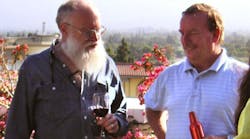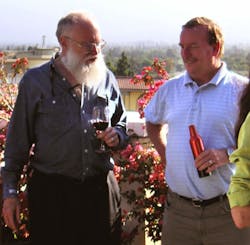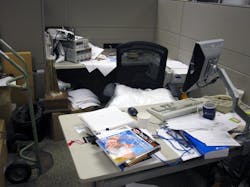This file type includes high resolution graphics and schematics.
It’s the second anniversary of Bob Pease’s tragic death, just a week after analog great Jim Williams died. I think of Bob most every day. He mentored me and several others at National Semiconductor (now Texas Instruments). Bob always had time for his fellow engineers. If you called him up with a problem, he did not ask how many chips you were going to buy. He would ask what your source impedance was and what power supply rails you had to work with. He did not suffer fools, but if he saw that you had thought about the problem and tried to solve it yourself, he would give his time willingly.
Related Articles
- Bob Pease Remembered One Year Later
- Remembering Bob Pease The Writer
- Bob Pease Remembered For Pease Porridge And A Whole Lot More
Bob used to say, “A soldering iron is my Spice.” So Texas Instruments application engineer Paul Grohe and I took him to lunch one day and presented him with a 200-W unit I found at the Electronic Flea Market (Fig. 1). I still see companies implying you can use simulation to eliminate prototyping. Pease knew that Spice might reduce a spin or two, especially for inexperienced engineers, but nothing beats real hardware.
Bob also knew that love of analog crossed company boundaries. For example, he was friends with Linear Technology’s Tim Regan, the amplifier applications manager (Fig. 2). Jim Williams’ wife, Siu, told me that Bob would often stop off at their home to show Jim some articles or clippings, or maybe to drop off some hardware or test equipment. Bob didn’t care if you worked for a competitor, as long as you loved analog. Some folks get into analog because it will make them a lot of money. Bob was into analog because it is beautiful.
Alan Martin, a factory applications engineer at Texas Instruments, was Bob’s friend. He snapped a picture of Bob’s new office the day after he died (Fig. 3). Note the Digi-Key magazine and the National Semiconductor Linear Applications Handbook on his desk. Bob would always be on the lookout for new information while being anchored in the traditions of analog design.
So rest in peace, my analog aficionado. Bob will be missed, but he will also be treasured. And he will serve as inspiration to the next batch of analog wizards to follow in his footsteps and stand on his mighty shoulders.
Paul Rako is a creative writer for Atmel corporate marketing. After attending GMI (now Kettering University) and the University of Michigan, he worked as an auto engineer in Detroit. He next moved to Silicon Valley to start an engineering consulting company. After his share of startups and contract work, he became an apps engineer at National Semiconductor and a marketing maven at Analog Devices. He also had a five-year stint at EDN magazine on the analog beat. He can be reached at [email protected].
This file type includes high resolution graphics and schematics.




